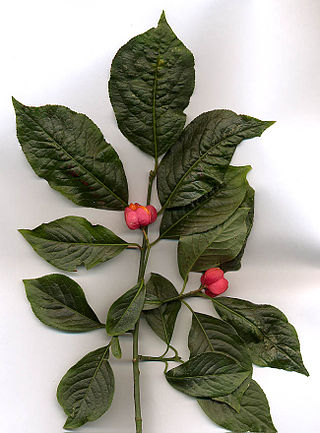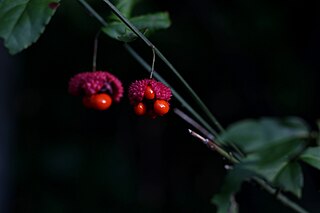
Euonymus is a genus of flowering plants in the staff vine family, Celastraceae. Common names vary widely among different species and between different English-speaking countries, but include spindle, burning-bush, strawberry-bush, wahoo, wintercreeper, or simply euonymus. It comprises about 130 species of deciduous and evergreen shrubs, small trees and lianas. They are mostly native to East Asia, extending to the Himalayas, and they are also distributed in Europe, Australasia, North America, and Madagascar. 50 species are endemic to China.

A subregion is a part of a larger region or continent. Cardinal directions are commonly used to define subregions. There are many criteria for creating systems of subregions; this article is focusing on the UN statistical geoscheme, which is a changing, constantly updated, UN tool based on specific political geography considerations relevant in UN statistics.

Dictamnus albus is a species of flowering plant in the family Rutaceae. It is also known as burning bush, dittany, gas plant or fraxinella. This herbaceous perennial has several geographical variants. It is native to warm, open woodland habitats in southern Europe, north Africa and much of Asia.
The redwing is a type of bird in the thrush family.
Stinkwood, german Stinkholz, french Bois Puant, is the common name for a number of trees or shrubs which have wood or plant parts with an unpleasant odour, including:

The United States has a racially and ethnically diverse population. At the federal level, race and ethnicity have been categorized separately. The most recent United States census recognized five racial categories, as well as people who belong to two or more of the racial categories. The United States also recognizes the broader notion of ethnicity. The 2000 census and 2010 American Community Survey inquired about the "ancestry" of residents, while the 2020 census allowed people to enter their "origins". The Census Bureau also classified respondents as either Hispanic or Latino, identifying as an ethnicity, which comprises the minority group in the nation.
Tiger lily or Tiger Lily may refer to:

Euonymus alatus, known variously as winged spindle, winged euonymus, or burning bush, is a species of flowering plant in the family Celastraceae, native to central and northern China, Japan, and Korea.

The United Nations geoscheme is a system which divides 248 countries and territories in the world into six continental regions, 22 geographical subregions, and two intermediary regions. It was devised by the United Nations Statistics Division (UNSD) based on the M49 coding classification. The creators note that "the assignment of countries or areas to specific groupings is for statistical convenience and does not imply any assumption regarding political or other affiliation of countries or territories".

Euonymus atropurpureus is a species of shrub in the bittersweet family. It has the common names American wahoo, eastern wahoo, burningbush and hearts bursting with love. It is native to eastern North America.

Euonymus fortunei, the spindle, Fortune's spindle, winter creeper or wintercreeper, is a species of flowering plant in the family Celastraceae, native to east Asia, including China, Korea, the Philippines and Japan. E. fortunei is highly invasive and damaging in the United States, causing the death of trees and forest in urban areas.

Lonicera maackii, the Amur honeysuckle, is a species of honeysuckle in the family Caprifoliaceae that is native to temperate eastern Asia; specifically in northern and western China south to Yunnan, Mongolia, Primorsky Krai in southeastern Siberia, Korea, and, albeit rare there, central and northern Honshū, Japan.

Euonymus americanus is a species of flowering plant in the family Celastraceae. Common names include strawberry bush, American strawberry bush, bursting-heart, hearts-a-bustin, and hearts-bustin'-with-love. It is native to the eastern United States, its distribution extending as far west as Texas. It has also been recorded in Ontario.
Palustris is a Latin word meaning "swampy" or "marshy", and may refer to:

Americans are the citizens and nationals of the United States. The United States is home to people of many racial and ethnic origins; consequently, American law does not equate nationality with race or ethnicity, but with citizenship and an oath of permanent allegiance.
Odoratus is a Latin adjective meaning "fragrant, perfumed", and may refer to:

Euonymus obovatus, the running strawberry bush, is a trailing, woodland groundcover plant of the family Celastraceae, which is native to North America in the eastern United States and south-eastern Canada.










